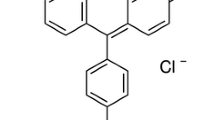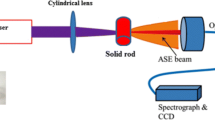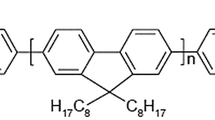Abstract
Solid state laser material based on oligomer 9,9,9′,9′,9″,9″-hexakis(octyl)-2,7′,2′,7″-trifluorene (HOTF) doped poly methyl methacrylate (PMMA) was fabricated. The absorption spectrum showed only one band at 355 nm with different concentration ratios (7–12 mM); thus the broad absorption band could be attributed to the α-phase formation. In addition, there was no new band detected at the end of the spectrum as the concentration increased. This indicates the absence of the β-phase formation for all concentrations used. On the other hand, HOTF exhibited two distinct emission bands at 420 and 470 nm for 7 mM concentration. When the concentration was increased to 9 mM, the intensity of the band 470 nm increased. Further increase the concentration to 12 mM, the intensity of the band at 420 nm totally vanished and there was only one band at 470 nm. Therefore, the band at 470 could be attributed to excimer state. However, the results revealed that there is a strong correlation between quantum yield of fluorescence and fluorescence life-time, absorption cross section, and emission cross section. Under pulsed laser excitation. The ASE spectrum of HOTF has been obtained using a transverse cavity configuration where the conjugated HOTF was pumped by the third-harmonic of Nd:YAG nanosecond pulsed laser (λex = 355 nm). We demonstrate that HOTF in the solid state could produce an ASE peak at 420 nm. The obtained results were compared with the HOTF and a conducting polymer poly (9,9-dioctylfluorene) (PFO)in the liquid state.







Similar content being viewed by others
References
Shirakawa, H., et al.: Synthesis of electrically conducting organic polymers: halogen derivatives of polyacetylene, (CH) X. J. Chem. Soc. Chem. Commun. 16, 578–580 (1977)
Li, G., Chang, W.H., Yang, Y.: Low-bandgap conjugated polymers enabling solution-processable tandem solar cells. Nat. Rev. Mater. 2(8), 17043 (2017)
Miller, J.S.: Conducting polymers—materials of commerce. Adv. Mater. 5(9), 671–676 (1993)
Brédas, J.L., Chance, R.R., Conjugated Polymeric Materials: Opportunities in Electronics, Optoelectronics, and Molecular Electronics, vol. 182. Springer Science & Business Media, Berlin (2012)
Jenekhe, S.A., Macromolecular Host–Guest Complexes: Optical, Optoelectronic, and Photorefractive Properties and Applications. Materials Research Society, San Francisco (1992)
Li, G., Zhu, R., Yang, Y.: Polymer solar cells. Nat. Photonics 6(3), 153–161 (2012)
Hoppe, H., Sariciftci, N.S.: Polymer solar cells. In: Marder, S., Lee, K.-S. (eds.) Photo responsive Polymers II, pp. 1–86. Springer, Berlin (2007)
Huynh, W.U., Dittmer, J.J., Alivisatos, A.P.: Hybrid nanorod-polymer solar cells. Science 295(5564), 2425–2427 (2002)
Kawase, T., et al.: Inkjet printed via-hole interconnections and resistors for all-polymer transistor circuits. Adv. Mater. 13(21), 1601 (2001)
Ahles, M., et al.: Light emission from a polymer transistor. Appl. Phys. Lett. 84(3), 428–430 (2004)
Mustapha, N., et al.: Improved efficiency of solar cells based on BEHP-co-MEH-PPV doped with ZnO nanoparticles. Optik Int. J. Light Electron Opt. 124(22), 5524–5527 (2013)
Pei, Q., et al.: Polymer light-emitting electrochemical cells. Science 269(5227), 1086 (1995)
Sirringhaus, H., Tessler, N., Friend, R.H.: Integrated optoelectronic devices based on conjugated polymers. Science 280(5370), 1741–1744 (1998)
Yang, Y., Heeger, A.: Polyaniline as a transparent electrode for polymer light-emitting diodes: lower operating voltage and higher efficiency. Appl. Phys. Lett. 64(10), 1245–1247 (1994)
Brabec, C.J., et al.: A low-bandgap semiconducting polymer for photovoltaic devices and infrared emitting diodes. Adv. Funct. Mater. 12(10), 709–712 (2002)
Fish, D., et al.: 32.1: Invited paper: a comparison of pixel circuits for active matrix polymer/organic LED displays. In: SID Symposium Digest of Technical Papers. Wiley Online Library (2002)
Huang, F., MacDiarmid, A., Hsieh, B.: An iodine-doped polymer light-emitting diode. Appl. Phys. Lett. 71(17), 2415–2417 (1997)
Idriss, H., et al.: Amplified spontaneous emission from the exciplex state of a conjugated polymer “PFO” in oleic acid. Opt. Laser Technol. 83, 148–152 (2016)
Masilamani, V., et al.: Laser properties of a conjugate polymer (MEH-PPV) in the liquid-excimeric state. Laser Phys. 17(12), 1367–1373 (2007)
Ibnaouf, K.: Amplified spontaneous emission spectra of poly (9,9-dioctylfluorenyl-2,7-diyl) under pulsed laser excitation. Synth. Met. 209, 534–543 (2015)
Ibnaouf, K.H.: Optical and amplified spontaneous emission from an efficient conducting copolymer (PFO-co-MEH-PPV) in solution. J. Luminesc. 192, 707–712 (2017)
Alsalhi, M., et al.: Excimer state of a conjugate polymer (MEH-PPV) in liquid solutions. Laser Phys. 17(12), 1361–1366 (2007)
Ibnaouf, K., et al.: Triple amplified spontaneous emissions from a conjugated copolymer BEHP-co-MEH-PPV in solution. Physica E 53, 66–71 (2013)
Ibnaouf, K., et al.: Dual ASE spectra from “Superexciplex” TICT states of dye molecules. Laser Phys. Lawrence 15(11), 1536 (2005)
Ibnaouf, K., et al.: Amplified spontaneous emission spectra from the superexciplex of coumarin 138. Spectrochim. Acta Part A Mol. Biomol. Spectrosc. 97, 1145–1151 (2012)
Laquai, F., et al.: Amplified spontaneous emission of poly(ladder-type phenylene)s—the influence of photophysical properties on ASE thresholds. Adv. Func. Mater. 18(20), 3265–3275 (2008)
McGehee, M.D., et al.: Semiconducting polymer distributed feedback lasers. Appl. Phys. Lett. 72(13), 1536–1538 (1998)
McGehee, M.D., et al.: Amplified spontaneous emission from photopumped films of a conjugated polymer. Phys. Rev. B 58(11), 7035 (1998)
Xia, R., et al.: Fluorene-based conjugated polymer optical gain media. Org. Electron. 4(2), 165–177 (2003)
Ibnaouf, K., et al.: Evidence for the double excimer state of conjugated polymer in a liquid solution. J. Eur. Opt. Soc. Rapid Publ. 8, 13001-1–13001- 5 (2013)
Prasad, S., et al.: High power amplified spontaneous emission from an oligomer in solution. J. Lumin. 168, 109–113 (2015)
Pisignano, D., et al.: Amplified spontaneous emission and efficient tunable laser emission from a substituted thiophene-based oligomer. Appl. Phys. Lett. 81(19), 3534–3536 (2002)
Shimizu, K., Mori, Y., Hotta, S.: Laser oscillation from hexagonal crystals of a thiophene/phenylene co-oligomer. J. Appl. Phys. 99(6), 063505 (2006)
Birnbaum, D., Fichou, D., Kohler, B.E.: The lowest energy singlet state of tetrathiophene, an oligomer of polythiophene. J. Chem. Phys. 96(1), 165–169 (1992)
Nagawa, M., et al.: Emission gain narrowing from single crystals of a thiophene/phenylene co-oligomer. Appl. Phys. Lett. 80(4), 544–546 (2002)
Zaman, S., et al.: Influence of the polymer concentration on the electroluminescence of ZnO nanorod/polymer hybrid light emitting diodes. J. Appl. Phys. 112(6), 064324 (2012)
Rickard, D., et al.: Quantifying the contributions of inner-filter, re-absorption and aggregation effects in the photoluminescence of high-concentration conjugated polymer solutions. J. Lumin. 128(1), 31–40 (2008)
Ibnaouf, K., et al.: Evidence for amplified spontaneous emission from double excimer of conjugated polymer (PDHF) in a liquid solution. Polymer 54(9), 2401–2405 (2013)
Ibnaouf, K.: Excimer state of a conjugated polymer (MEH-PPV) in thin films. Opt. Laser Technol. 48, 401–404 (2013)
Prasad, S., et al.: Laser from the dimer state of a conjugated polymer (PFO) in solution. Polymer 55(3), 727–732 (2014)
Mujamammi, W.M., et al.: Relaxation oscillation with picosecond spikes in a conjugated polymer laser. Polymers 8(10), 364 (2016)
Misaki, M., et al.: Highly efficient polarized polymer light-emitting diodes utilizing oriented films of β-phase poly(9,9-dioctylfluorene). Appl. Phys. Lett. 93(2), 250 (2008)
Zainelabdin, A., et al.: Stable white light electroluminescence from highly flexible polymer/ZnO nanorods hybrid heterojunction grown at 50 C. Nanoscale Res. Lett. 5(9), 1442 (2010)
Nagy, A.M., et al.: Fluorescence lifetimes of rhodamine dyes in vacuo. J. Photochem. Photobiol. A 244, 47–53 (2012)
Williams, A.T.R., Winfield, S.A., Miller, J.N.: Relative fluorescence quantum yields using a computer-controlled luminescence spectrometer. Analyst 108(1290), 1067–1071 (1983)
Horiba, J.Y.: A guide to recording fluorescence quantum yields (2009). http://www.horiba.com/fileadmin/uploads/Scientific/Documents/Fluorescence/quantumyieldstrad.pdf
Fischer, M., Georges, J.: Fluorescence quantum yield of rhodamine 6G in ethanol as a function of concentration using thermal lens spectrometry. Chem. Phys. Lett. 260(1–2), 115–118 (1996)
Skoog, D.A., Holler, F., Timothy, A.D.A.: Principios de análisis instrumental. McGraw-Hill Interamericana de España, España (2001)
Magde, D., Wong, R., Seybold, P.G.: Fluorescence quantum yields and their relation to lifetimes of rhodamine 6G and fluorescein in nine solvents: improved absolute standards for quantum yields. Photochem. Photobiol. 75(4), 327–334 (2002)
Sabry, M., et al.: Fluorescence and laser activity of some pyrazinyl schiff-base derivatives. Journal de chimie physique 86, 2163–2172 (1989)
Wegmann, G., et al.: Laser emission from a solid conjugated polymer: gain, tunability, and coherence. Phys. Rev. B 57(8), R4218 (1998)
Tapia, M.J., et al.: β-Phase formation of poly (9,9-dioctylfluorene) induced by liposome phospholipid bilayers. J. Phys. Chem. B 115(19), 5794–5800 (2011)
del Valle, J.C., Kasha, M., Catalán, J.: Spectroscopy of amplified spontaneous emission laser spikes in phenyloxazoles. Prototype classes. J. Phys. Chem. A 101(18), 3260–3272 (1997)
Al-Shamiri, H.A.S., Badr, Y., Kana, M.T.A.: Optical, photo-physical properties and photostability of laser dyes impregnated in sol–gel matrix. In: Electronics, Communications and Photonics Conference (SIECPC), 2011 Saudi International. IEEE (2011)
Author information
Authors and Affiliations
Corresponding author
Rights and permissions
About this article
Cite this article
Ibnaouf, K.H., Taha, K.K., Idriss, H. et al. Solid state ASE from an oligomer (HOTF) in polymethyl methacrylate. Opt Rev 26, 103–110 (2019). https://doi.org/10.1007/s10043-018-0485-5
Received:
Accepted:
Published:
Issue Date:
DOI: https://doi.org/10.1007/s10043-018-0485-5




